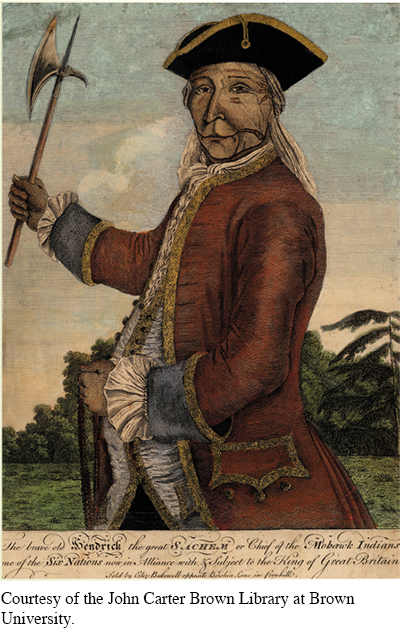Making Historical Arguments: Why Did the Mohawk Chief Hendrick Fight with the British against the French in 1755?
140
Why Did the Mohawk Chief Hendrick Fight with the British against the French in 1755?
When a thousand provincial troops marched north through New York to engage the French enemy in fall of 1755, they were joined by just one Indian tribe, the Mohawks. Despite his advanced age, the white-
Most Native Americans of the 1750s favored the French in the Seven Years’ War, seeing the British as more intrusive and land hungry. But Chief Hendrick’s particular experiences gave him a more nuanced perspective on the British. Mohawk lands were not isolated; they lay close to the British seat of government in New York City and even closer to Dutch-
Hendrick’s most notable success was a decades-
In 1753, Hendrick’s diplomatic efforts were in danger, with French-
Hendrick staged a forceful complaint in New York City, accusing the assembly of breaking the Covenant Chain and ending with stern words for the royal governor: “So brother you are not to expect to hear of me any more, and Brother we desire to hear no more of you.” When news of this speech reached London, alarmed British officials called for the Albany Congress to repair the Mohawk alliance. From the imperial perspective, this was no time for Britain to lose its best Indian ally—

At the Albany Congress, held in summer of 1754, delegates from New York extended a peaceful but not fully welcoming hand to reestablish the Covenant Chain. The Indians in attendance judged the effort to be insufficiently apologetic for past neglect. While accepting the belt symbolizing the alliance, Hendrick again gave a powerful speech designed to shame the colonial delegates. He grasped a stick and threw it behind him, saying, “You have thus thrown us behind your back, and disregarded us, whereas the French are a subtle and vigilant people, ever using their utmost endeavours to seduce and bring our people over to them.” Hendrick reminded them of French fort building in the Ohio Country, met with inaction by the British. He concluded by casting the French-
Hendrick’s fame spread far with this astute speech, and his reproach of the colonists gained him favor with war hawks in Britain. In 1755, the governor of Pennsylvania invited him to Philadelphia, hopeful the chief could have influence on disputed land deals with Indians in western Pennsylvania. The Pennsylvania assembly treated him as an honored guest, as did an elite men’s club whose members raised private donations to win his favor.
By fall of 1755, the Seven Years’ War had spread to the northern front. Sir William Johnson commanded the thousand provincial troops who marched north into French territory, and with him was his close friend Chief Hendrick with two hundred warriors. French troops and their Montreal Indian allies staged an ambush, but before the trap could be sprung, one of the French Mohawks in hiding recognized Hendrick, a white-
Chief Hendrick was mourned as a hero by the British Americans. Ships were named for him, as were two taverns in Philadelphia. Periodicals in Britain and America published a detailed account of his death in battle. Celebrated for his stirring speeches and courageous death, Hendrick above all was valued for his singular loyalty to the British.
Questions for Analysis
Summarize the Argument: In light of his scolding speeches criticizing the British, how was it that Chief Hendrick came to be so celebrated by the British Americans in 1755?
Analyze the Evidence: What evidence does the author cite to build the case that Hendrick was an unusually talented intercultural broker?
Consider the Context: The British had slender support of Native Americans in the Seven Years’ War, yet they won on the American continent. Why?